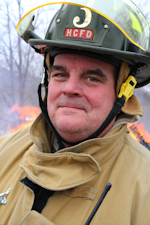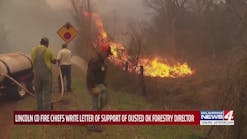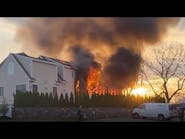SAN DIEGO—Everyone in the fire service knows firefighting is a dangerous profession. Most of the hazards are obvious, but some of the ones that are virtually unseen are just as deadly.
During an all-day class at Firehouse World, two experts in the field gave a presentation titled “International Perspective on Managing Firefighter Toxic Exposure Reducing Risk on the Fireground and in Live Fire Training.”
The presenters were Dr. Gavin Horn, research program director for the Illinois Fire Service Institute and Dr. Stefan Svensson, an associate professor at Lund University, Sweden. Both have decades of experience as firefighters.
Horn said toxins in the fire service was never a big topic, until the correlation between the increase in cancer occurrences and firefighting was noticed.
“Forty years ago, it was never talked about,” Horn said. “Then, someone noticed there’s a correlation between what we do and cancer.”
Horn said the science on the topic is just emerging as more people study the problem and find there are more questions than answers.
“We don’t know all the answers, but from my perspective we can’t wait to have all the answers before we do something,” Horn said. “We have to look at what is the risk and what are reasonable steps to reduce them.”
Horn recalls a time when firefighters resisted wearing SCBAs “unless it was really, really bad,” and didn’t like to wear PPE either.
“We have to think about work place practices and how does it impact our health,” Horn said. “I wish we had all the answers, but we don’t have all the answers.” He said his fire department, in Savoy, IL, is having challenges implementing best practices and his department is “relatively well funded.”
Svensson said the issues are very similar in Sweden. He said firefighters are taught to fight pallet and straw fires, which are approved fuels, but burn very differently than modern furniture and building construction materials.
“It’s a big problem and I don’t have all the answers,” Svensson said.
Horn said there are statistics that show a steady decline in fires, down to four percent of all calls in the United States, yet the injury and fire death statistics, while down, do not reflect the precipitous decrease in fire calls.
Cardiac arrest continues to be the single largest cause of firefighter fatalities, at about 51 percent, Horn said. Part of that increase can be attributed to modern PPE, which is better than ever and protects firefighters, but contributes to heat stress because of the lack of air flow, Horn said.
While statistics are fairly easy to get for firefighter line-of-duty deaths and injuries, they are “incredibly difficult” to get for cancer deaths and injuries.
“We don’t have a database, nationally,” Horn said. What is known is “staggering,” he said, adding that the cancer rate among firefighters is 37 percent, while it is 23 percent in the general population. Some types of cancers, like Mesothelioma, have a rate that is double among firefighters.
Horn added that the cancer rates among firefighters is similar across multiple countries and regions, like in the Nordic regions, Australia and California. They are reflected in the NIOSH reports on the topic as well.
“These numbers are huge for presumptive legislation,” Horn said. “And they’re huge for education and prevention."
While the statistics may be difficult to get, there are many ways to prevent the events that cause the statistics in the first place.
Horn said that the neck, which is typically protected by just a single-layer fabric hood, is an area of the body that is susceptible to absorbing carcinogens.
He said manufacturers are looking for a way to prevent the toxic soot from penetrating to the skin. That can be a challenge since the hood must interface with the SCBA face mask and the bunker coat.
Post-fire cleanup
There’s also research that shows using a variety of wipes, from inexpensive big-box store brand baby wipes to products that claim to be made specifically for firefighters, help mitigate the cancer risk, Horn said. Up to 50 percent of the cancer-causing toxics can be removed by using wipes, he said, cautioning that there’s not much hard data or research to back that claim up. He added there is no evidence to say any will prevent cancer.
“Some of the claims are concerning to me,” Horn said. “Any claim that they can prevent cancer is dangerous at best.”
Horn said firefighters should also be circumspect when considering expensive hoods that say they block carcinogens. There are no standards governing such claims so manufacturers can say whatever they want with little evidence to support the claim, he said.
Horn said firefighters can change tactics to reduce risk as well. Dirty gear can cause secondary exposures by transferring bad stuff into the cabs of apparatus back to the stations.
Washing hands regularly is also a good idea to prevent transfers to food and beverages consumed during rehabilitation, Horn said, adding that ingestion is a very effective way of getting carcinogens into the body quickly.
“Hygiene hasn’t been worked into rehab as well as it should be,” Horn said. He also said that even going to the bathroom during rehab, without hand washing can present a huge risk as the scrotum has the thinnest skin on the body making it a very easy place for absorption to occur.
Horn said even things like fire hose needs to be decontaminated properly to avoid repeated exposure and clean gear goes without saying.
But, perhaps the most cost-effective method of preventing the transfer and absorption is effective leadership, Horn said.
“Make them wear their SCBAs,” Horn said. “Make them wear their gear.”
Fitness plays a roll
Svensson said the physical fitness of firefighters can help them battle cancer and should be considered among the solutions to the problem. He said cardiac issues among firefighters in Sweden is almost non-existent.
“Firefighters are generally fit and healthy and keep in shape, so they shouldn’t have problems with their hearts,” Svensson said, adding that mortality and morbidity for firefighter fatal cardiac events is 4 percent.
He said the biggest problem with firefighter injuries in Sweden is sports activities. Soccer and hockey in full-time stations are popular and firefighters kick each other.
Both men said education and more research will be key to continued reduction in exposures to toxic substances.
“Because it has been identified, we have to do something about it,” Svensson said. “The lack of knowledge is the real cause of most deaths and injuries.”

Ed Ballam
Ed Ballam served as associate editor for Firehouse. He is the assistant chief of the Haverhill Corner, N.H. Fire Department, and a National Registered EMT. He is also a Deputy Forest Fire Warden for the New Hampshire Division of Forests and Lands. Professionally, he's been a journalist for over 35 years working for a variety of publications, including employment as managing editor of a national fire service trade journal for more than a decade.






